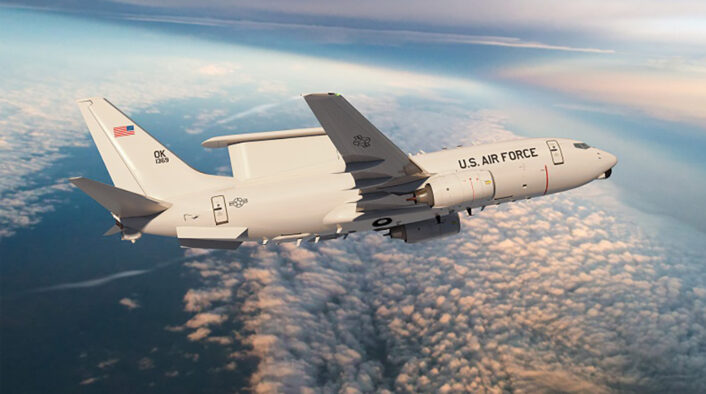U.S. Air Force pilots and air battle managers are getting “hand-on” experience with the E-7A Wedgetail during the latest iteration of Pitch Black.
Beginning in 2022, the U.S. Air Force initiated a program to embed its Airmen with the Royal Australian Air Force (RAAF) E-7A Wedgetail units through the Military Personnel Exchange Program. This move is in preparation for replacing the aging E-3 Sentry Airborne Warning and Control System (AWACS) with the more advanced E-7A Wedgetail.
This collaboration is a testament to the long-standing partnership between the U.S. and Australia, which dates back to 1940. Over 84 years of consistent cooperation have been strengthened by joint exercises and global interactions. One such exercise, Pitch Black, has seen U.S. participation since 1983 and serves as a key opportunity for embedded U.S. Air Force Airmen to gain valuable operational experience with the E-7A Wedgetail.
During Pitch Black 2024, U.S. Airmen embedded with the RAAF 2 Squadron gain hands-on experience with the E-7A Wedgetail, preparing them for future operations with the aircraft. Maj. Oliver Ngayan, an air battle manager with the 2 Squadron E-7A Wedgetail, emphasized the importance of this integration: “For us, the purpose is really to get a familiarity of the E-7A Wedgetail from the Australians who have been operating it for a long time. We integrate into their unit to learn how they operate the E-7A and take back that knowledge to develop our own procedures.”

The exchange program goes beyond just familiarizing U.S. Airmen with the aircraft. It also fosters collaboration on operational tactics and problem-solving strategies. U.S. Air Force Capt. Trevor Ahnder, a 2 Squadron E-7A Wedgetail pilot, noted, “Most of us have a lot of time on our platforms and we’re learning new ways of doing things. RAAF members look at tactics one way, we look at it another, and being able to analyze the differences and find solutions is incredibly valuable. I am incredibly grateful for this opportunity to work together and build better processes.”

While the U.S. Airmen benefit from this hands-on experience, they also contribute their knowledge to the RAAF, ensuring a two-way flow of information and expertise. RAAF Squadron Leader Darren Lindsey, the 2 Squadron Detachment commander, highlighted the mutual benefits of this collaboration: “With the inclusion of the United States Air Force alongside us on aircrew here, we’ve been able to take elements from their long history of the E-3 Sentry and bring that towards the E-7A Wedgetail. It’s a great privilege to be able to lead the Wedgetail deployment here for Pitch Black 2024, which allows us to integrate with numerous partners, but also showcase to our friends in the United States Air Force.”
Exercise Pitch Black underscores the importance of international cooperation, from individual interactions to coordinated air operations among nations. This collaboration is vital for maintaining a secure, open, prosperous, and resilient Indo-Pacific region. Through these joint efforts, both the U.S. and Australian forces enhance their operational capabilities and strengthen their partnership, ensuring they are well-prepared for future challenges.
U.S. Air Force E-7A Program
In 2022, the E-7 was chosen to replace the aging E-3, leading to the formation of the E-7A Program Management Office and the initial acquisition of two aircraft through a rapid prototyping pathway. The E-7A will serve as the primary airborne sensor for the Department of Defense, providing advanced detection, identification, and tracking capabilities to Joint Force commanders. It features advanced Airborne Moving Target Indication and Battle Management, Command and Control capabilities, and a Multi-Role Electronically Scanned Array (MESA) radar, which offers 360-degree surveillance without the need for rotation like the E-3 Sentry’s antenna.
Initially developed for the Royal Australian Air Force under Project Wedgetail, the E-7 has since been adopted (or chosen) by the air forces of South Korea, Turkey, the United Kingdom and NATO. The E-7 is based on the commercial Boeing 737-700, leveraging existing design and supply chains to reduce development and logistics costs and expedite its fielding.

In 2023 Boeing announced plans to develop two variants of the E-7, with an emphasis on integrating Open Mission Systems (OMS)-compliant components to enhance capabilities. This OMS architecture allows for rapid and cost-effective updates to operational aircraft, aligning with defense budget constraints. The E-7 integrates Boeing’s Battle Management Command and Control (BMC2) system and Northrop Grumman’s advanced wide-band Active Electronically Scanned Array (AESA) radar, enhancing its operational effectiveness in multi-domain environments.
The MESA radar, developed by Northrop Grumman and mounted on the E-7’s dorsal fin, provides comprehensive air-to-air and air-to-surface surveillance with integrated Identification Friend or Foe capabilities. This radar delivers critical domain awareness, enabling the detection and identification of adversarial targets at long ranges and adaptation to emerging tactical scenarios.
The development work for the E-7 was initially expected to be completed by August 2024, with production slated to begin in fiscal 2025. The first E-7A was anticipated to be operational by fiscal 2027, and the U.S. Air Force plans to acquire a total of 26 E-7As by fiscal 2032. Meanwhile, the E-3 fleet will receive upgrades to maintain its Battle Management, Command and Control, and Airborne Moving Target Indication operations until the E-7 is fully operational.
However, it wasn’t until recently that the U.S. Air Force and Boeing announced an agreement to develop the first rapid prototype of the E-7 battle management aircraft. The deal includes the construction of 26 E-7s by 2032. This decision follows detailed negotiations to meet the Air Force’s specific requirements at a reasonable cost.










